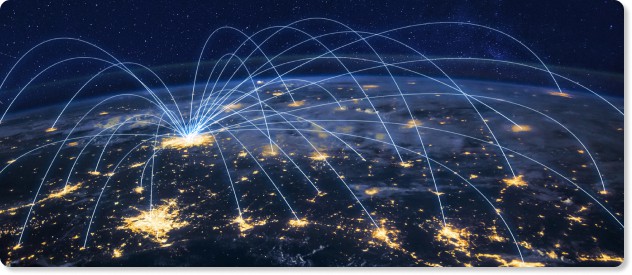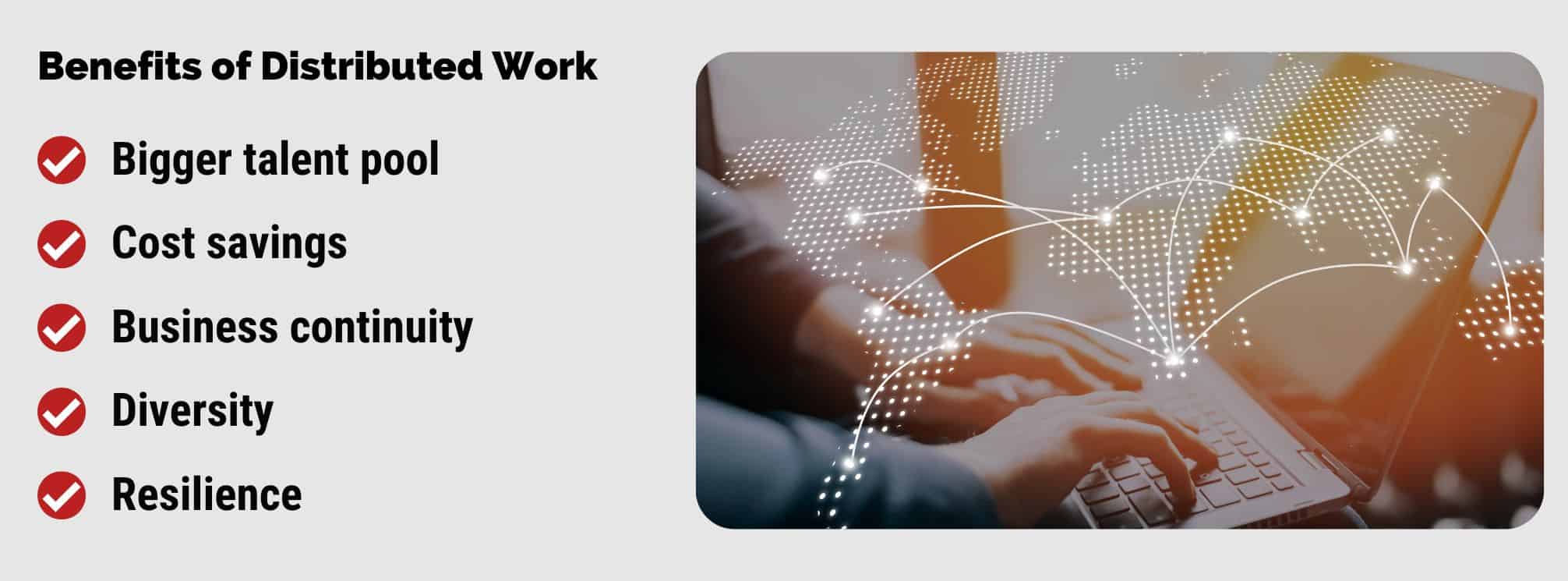What is a Distributed Workforce? Embracing the Future of Work
Long gone are the days of everyone needing to work side-by-side in an office or facility to be successful. As the world has become more connected with the internet and technology, distributed work has become more and more common. In this comprehensive guide, we’ll define what a distributed workforce is and why it’s something to be embraced.
What is a Distributed Workforce?
A distributed workforce refers to a workforce that is geographically dispersed, with employees located in different physical locations rather than being centralized in a single office or location.
In a distributed workforce, employees can work remotely, be dispersed in satellite offices and co-working spaces, and even have a mix of corporate and frontline employees. This arrangement allows companies to tap into a wider talent pool.
The meaning of a distributed workforce extends beyond physical distance. It also encompasses the use of technology and digital tools to facilitate communication, collaboration, and the execution of work tasks.
With advancements in technology, businesses can create a virtual work environment where employees can connect and engage with colleagues, access company resources, and collaborate on projects seamlessly.
Distributed workforces have become increasingly prevalent due to various factors, including the rise of remote work, globalization, and the need for business continuity in the face of disruptions.
What is an Example of a Distributed Team?
Since there are now many different types of work (e.g. frontline, remote, hybrid, in-office, etc.) there are many different examples of distributed teams. Let’s go through a few examples.
- Distributed offices. Even if your company is full of employees who all work within a corporate office, you still can have a distributed workforce if you have many different satellite offices. For example, insurance companies have their individual branches in towns and cities as well as a headquarters.
- Frontline and support staff. Companies like large food and retail chains have their frontline employees working in stores and restaurants, but they also have workers in a corporate office (or even remote/hybrid) supporting those frontline teams.
- Hybrid Workplaces. Companies may also be distributed by employing employees who are office staff, hybrid, and/or remote workers.
There are no shortage of examples of distributed teams. If your company has workers that are spread out in some way then you are distributed.
Is Distributed Work the Same as Remote Work?
These two terms are related, but not the same. Remote work applies to an individual’s working conditions for a company and implies that they work somewhere other than a corporate office. This could be from their home or from any internet-enabled location.
Companies who embrace remote work are therefore distributed because their employees work from anywhere and aren’t gathered in a central place.
The Top Benefits of Having a Distributed Workforce
The benefits of a distributed workforce are significant and can have a profound impact on both companies and employees. Here’s why embracing distributed work can be a smart business decision:
- Access to a broader talent pool. By embracing a distributed workforce, businesses can tap into a vast talent pool that extends beyond their local area. By hiring top talent from different geographic locations, you naturally bring in diverse perspectives, skills, and experiences. This access to a global talent pool can enhance innovation, problem-solving, and creativity within the organization.
- Cost savings. Operating a distributed workforce can lead to substantial cost savings. With employees working remotely or in satellite offices, there is a reduced need for large office spaces and associated expenses. Companies can save on rent, utilities, office supplies, and maintenance costs. Additionally, if companies embrace remote work as part of your distributed work strategy, they can reduce commuting expenses.
- Business continuity and resilience. Distributed workforces offer companies increased resilience in the face of unforeseen events, such as natural disasters or public health emergencies. With employees located in different regions or working remotely, the impact of disruptions in one area can be mitigated. Business operations can continue uninterrupted, ensuring ongoing service delivery to clients and customers.
The Challenges of Managing a Distributed Workforce
Managing distributed employees comes with its own set of challenges. While the benefits are substantial, companies must be prepared for these difficulties.
- Communication. Effective communication and collaboration becomes harder when teams are geographically dispersed and in different time zones. Without face-to-face interactions, there may be a greater reliance on digital communication tools, which can sometimes lead to misunderstandings. It’s crucial to establish clear communication channels and promote open and transparent communication practices.
- Building and maintaining trust. Trust is the foundation of any successful team. It can be challenging for senior leaders to build trust with a distributed workforce if they don’t have a thoughtful executive communications strategy.
- Managing performance. Managers already struggle with having tough conversations and communicating effectively. They can especially struggle if they’re then asked to manage workers in a variety of locations. That’s why traditional performance management approaches need to be adapted. Employees need clear performance expectations and goals communicated to them. And managers need to be trained and held accountable for regular check-ins and providing feedback.
- Engagement and motivation. Ensuring high levels of employee engagement can be more challenging when team members are spread out. Without the daily in-person interactions and shared experiences, employees may feel isolated from the company and their peers. That’s why it’s crucial to implement strategies to foster employee engagement, such as virtual team-building activities, recognition programs, and opportunities for social interaction.
- Information security and data privacy. With employees working remotely or in different locations, ensuring information security and data privacy becomes increasingly important. While there are ways to secure your company’s information, you must take the necessary steps.
By recognizing and addressing these challenges, companies can develop strategies, policies, and practices that effectively manage a distributed workforce. We’ll provide some guidance in the next section.
Distributed Workforce Strategies for Communication and Engagement
Because the primary challenges facing distributed companies are communication and engagement, let’s focus on a few strategies to address these issues head-on.
1. Build a Strong Remote-First Culture
At theEMPLOYEEapp, we strongly believe that you don’t need to all be under one roof to have a strong and positive company culture. Unfortunately, many companies have built their cultures around this “office environment.”
But what happens when one office environment has a better culture than another satellite office? Or when your remote employees feel excluded because everything you do in the name of “culture” biases towards an in-person event?
To ensure everyone feels included and part of your culture—and therefore more likely to be loyal and not churn—you need to focus on a remote-first culture. What makes it “remote-first” is that this is a culture-building strategy that does not require in-person interaction.
Here’s how you do it:
- Invest in the right channels for your specific audience.
- Survey your people regularly about how they want to engage and be communicated with. Take the guesswork out of it and just ask!
- Find and develop champions across the organization to reinforce your culture and drive interactions regionally.
- Properly train your managers to be better at individualized outreach on both digital channels and face-to-face.
[optin-monster slug=”dvcuabs8ioe7aw2sjvr7″ followrules=”true”]
2. Overcome Engagement and Motivation Challenges
A big fear companies have about remote work is that their employees won’t work as hard or they won’t be able to “spot” the signs of quiet quitting or absenteeism.
But Stanford research has actually found that remote workers are 13% more productive than office staff. So, your fears about low motivation and productivity shouldn’t alarm you. That doesn’t mean you shouldn’t prioritize making sure you have the right support and managerial structures in place. But it does mean you shouldn’t treat your remote teams like they’re lazy. Because, they aren’t.
The real issue with engagement and motivation at distributed companies is that not all employee groups are treated equally. Certain offices might have more perks. Remote workers might not feel like they have the right tech to do their jobs. Inequity can lead to feelings of not being valued, which causes disengagement.
When it comes to boosting employee engagement, here’s what you need to do:
- Use surveys and interviews to find where you might have inequities in your company. This could be things like poor communication, resources, support, or management in certain divisions but not others.
- Communicate your plan for how you want to support everyone equally. And then put your money where your mouth is. This could include investing in new digital channels or revamping your onboarding or recognition programs to be more inclusive of deskless and remote employees.
3. Create an Impactful Content Strategy
Once you have great channels, that’s not always enough. There are many companies who have all the internal communication tools they could need but still struggle with engagement and retention.
Why? Because of the content!
A great content strategy is key to engaging your distributed workforce. Here are a few ways to determine if your content needs some work:
- Conduct an audit. An internal comms audit is an amazing tool to help you discover gaps in your current strategy.
- Assess your content with a Stop, Start, Continue Analysis. These audits can help you create action plans for exactly what you want to change about your current strategy.
- Use an editorial calendar if you don’t already. We don’t know how anyone stays organized without a content calendar. They are a must for creating a content plan and sticking to your cadence!
Technology Solutions for Distributed Teams
The right Tech Stack plays a crucial role in enabling effective communication, collaboration, and management of distributed teams. Luckily, there are now plenty of digital tools and platforms to choose from.
Here are some technology solutions that can help you support your distributed teams:
- Communication platforms (like theEMPLOYEEapp). Robust communication solutions are essential for keeping distributed teams connected and informed. This includes things like email, mobile apps, sms texting, intranets, etc.
- Virtual meeting tools. Web conferencing tools are critical for facilitating face-to-face interactions and team meetings in a distributed work environment. Platforms like Zoom, Microsoft Teams, and Cisco Webex offer video conferencing capabilities, screen sharing, and recording options.
- Project management software. Project management software such as Asana, Trello, and Jira provide features for task management, project tracking, and team collaboration. These tools help distributed workforces organize workflows, assign tasks, set deadlines, and monitor project progress, ensuring that everyone stays aligned and focused.
- Knowledge sharing and document collaboration. Knowledge sharing is crucial for distributed teams to access information, share expertise, and collaborate on documents and projects. Platforms like SharePoint, Confluence, and Google Drive offer centralized repositories for storing and sharing documents, ensuring that team members have access to the latest information and can collaborate on files in real time.
When selecting technology solutions for distributed teams, it’s essential to consider factors such as ease of use, scalability, security, and integration capabilities. The right combination of technology tools will enable seamless communication, efficient collaboration, and effective management of distributed teams, ultimately leading to increased productivity and success in a distributed work environment.
[optin-monster slug=”o3ki2giaarmn1jxrt6ys” followrules=”true”]
Success Stories: Reaching Distributed Workers Where They Are
theEMPLOYEEapp is a comprehensive mobile app, intranet, and texting solution designed specifically for internal communication and employee engagement. With theEMPLOYEEapp, organizations can reach their distributed workforce effectively, ensuring that important information and updates are delivered to all employees, regardless of their location.
Let’s explore a few success stories that highlight how organizations have leveraged theEMPLOYEEapp to reach their distributed workforce:
- Kreg Tool Company faced challenges in communicating with nearly 50% of their employees who worked on the plant floor without easy access to company email or their intranet. By implementing a mobile app solution like theEMPLOYEEapp, Kreg Tool successfully bridged the communication gap. The app allowed them to deliver important company information directly to employees’ mobile devices, ensuring that crucial updates reached all employees, regardless of their location within the organization.
- KR Wolfe has a very distributed workforce. 90% of their staff are remote technicians who travel extensively. This meant KR Wolfe encountered difficulties ensuring effective communication. Emails often got buried amidst the overwhelming amount of communication channels. By adopting theEMPLOYEEapp, KR Wolfe gave their distributed workforce a dedicated employee comms platform. This resulted in improved engagement, enhanced collaboration, and a more connected workforce.
- Mohegan Sun faced communication challenges with employees who lacked access to computers at work and did not have company-provided email addresses. They relied on multiple communication tools, including newsletters, an on-site intranet, printed materials, and newscasts displayed on TVs in employee-only areas. However, it was difficult to measure the impact of each channel and ensure information reached all teams. Mohegan Sun turned to theEMPLOYEEapp to create a centralized communication platform accessible via mobile devices.
Ready to learn more about how you can reach your distributed workforce more effectively? Request a 30-minute demo of theEMPLOYEEapp today.
[optin-monster slug=”ucyxtz2fxemh6aryl4gg” followrules=”true”]




